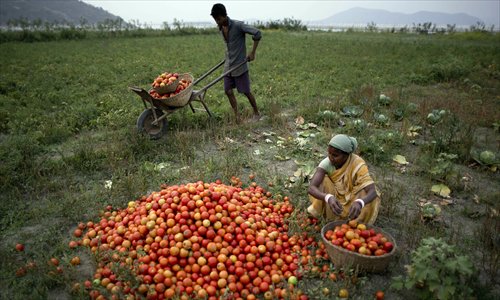India’s climate change dilemma
Livelihood of farmers, forest dwellers threatened

Indian farmers harvest tomatoes at a farm along the River Brahmaputra on the outskirts of Gauhati, India. Photo: IC
From coastal to tropical and sub-tropical regions, farmers and forest dwellers across the eastern Indian state of Odisha encounter livelihood issues as climate change has severely impacted agriculture and forced people to migrate.
"With the climate changing faster since 1980s, we have been living under threats from nature. Rain patterns have become abnormal and unpredictable. We have lost our basic livelihood source - agriculture," said Gandharba Kandoi, a farmer in Udaykani village on the fringe of the Bay of Bengal.
"We have been experiencing extreme weather conditions since 1999, the year a super cyclone took more than 10,000 lives," Kandoi added.
"The saline water has been our biggest enemy. It regularly damages our crops and forces us to leave the village as there is no alternate livelihood option in this place," said Dhabaleswar Pradhan, a farmer from a nearby village.
Forced to leave
Realizing the threat to their livelihood, many from these villages have already moved to other places. They turned into migrant laborers just to survive.
"About half of the youth from each of the villages has left the state as laborers. Even if their parents need the young members of the family to remain with them, they have no other choice," says Harihar Jena, a local social worker.
Climate change has also impacted the lives of the agrarian tribal communities living in tropical and sub-tropical regions. Erratic rain patterns have hit agriculture hard.
"Upland paddy fields normally encounter dry spells. Low lands with some irrigation facilities fail to provide for our family's food requirements," said Sumani Jhodia, a female farmer as well as community leader from Kashipur in south Odisha.
Deforestation and industrialization in the name of development has largely affected the tropical climate as well.
Apart from agriculture, forests have become unreliable to tribal and other forest dwellers who, since many generations, are dependent on roots, stems, fruits and other forest products.
Industrialization's impact
In view of the drastic change in the climate since the Vedanta Aluminium plant was established on the foot of Niyamgiri hill, tribal leader Kumti Majhi said, "We believe the forest does not produce fruits and stems as much as before and rainfall is not as frequent."
"For the past five to six years, we feel that the rainfall pattern has been affected by industrialization in the area. We have frequently been suffering from cholera outbreaks. The rainfall has been drastically reduced," said Dillip Kumar Das, a developmental activist who heads Antodaya, a non-government organization working for the people's welfare in the poverty-stricken Kalahandi district.
The situation is even worse in places where large-scale mining activities are taking place. In Barbil, the hub of iron ore mining, people are virtually forced to abandon agriculture work.
"We wanted to continue with farming. But the flush water from the hills and the mineral dust have been lethal to our agriculture. So most of the tribal people have abandoned their land and opted to work in the mines or railway siding sites," said Bhagaban Chatamba, a tribal leader of the mineral-rich Keonjhar district.
Because of excessive mining activities and subsequent deforestation, "the rainy season has shifted. Rainfall is delayed by two months and doesn't occur as much," said Abhay Kumar Mishra, a development worker in the Joda-Barbil mining cluster.
"Extreme weather together with pollution from mining activities have also made people vulnerable to health hazards like asthma and malaria," Mishra added.
Asked about the impact of climate change on agriculture, agronomist Hemant Kumar Sahu said, "Due to climate change our agriculture is suffering the most. We are now training farmers to diversify their crops, crops that can withstand climate change."
Finding a solution
Following the advice of scientists and various policy advocates, "many farmers living in the seaside villages of Odisha have opted to raise betel vines instead of the usual paddy cultivation. Yes, they are earning more these days. But since the farmers do not work in the paddies, their profit is used to buy food. This is a problem because of high food prices," said social activist N A Shah Ansari, who runs a community radio station.
Government policies promote mono-cropping and commercial farming.
But this not only prevents tribal farmers from growing a variety of crops and millets to meet their food requirements, but also leaves a majority of tribal farm laborers unemployed.
However, developmental policy analysts believe that the communities have their own take on how to deal with the problems.
"But the problem is that their knowledge is never taken into account by the scientific community working in the area, which ultimately results in a wide policy gap," said Vidhya Das, a known developmental policy analyst and director of Agragami, a non-profit organization working on the rights and welfare of indigenous communities.
"There is conservation agriculture, which is known to sequester carbon into the soil and reduce carbon emissions; there is agro-ecology which is being practiced, and Latin America has huge projects on agro-ecology," Das said.
"Swedish farmers are showing the way in this field of agriculture. And if you import that expertise and try to combine it with local knowledge, the tribal people's agriculture and the livelihood systems will thrive."
The author is a Bhubaneswar-based journalist in India. basudev.news@gmail.com